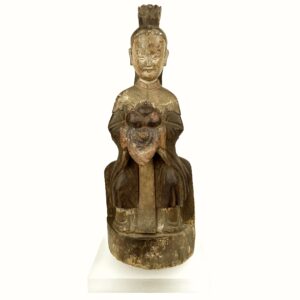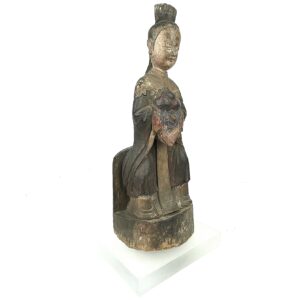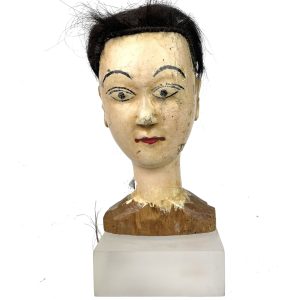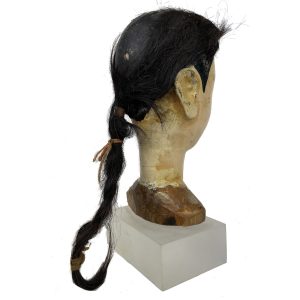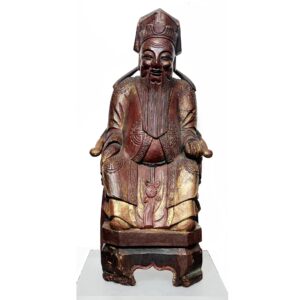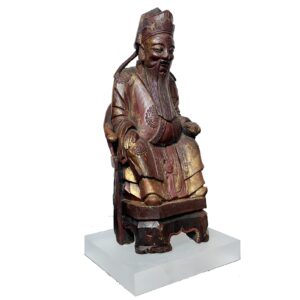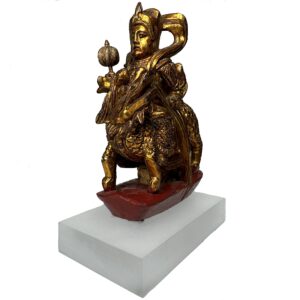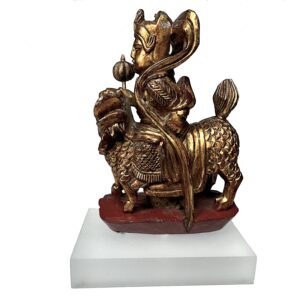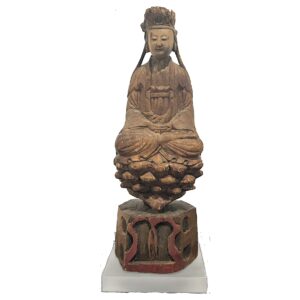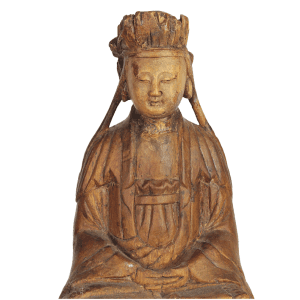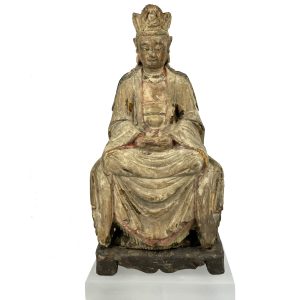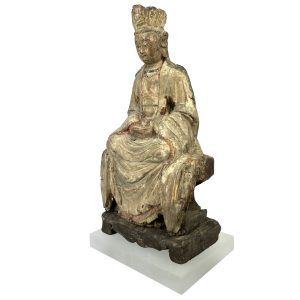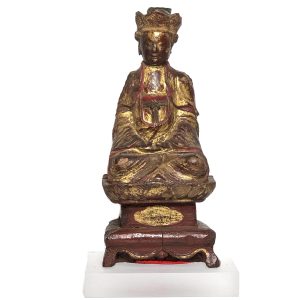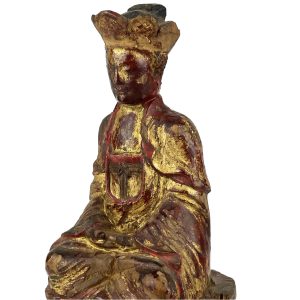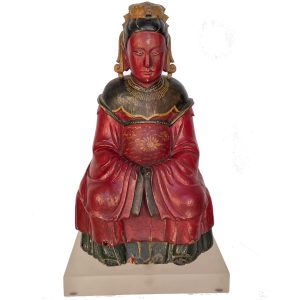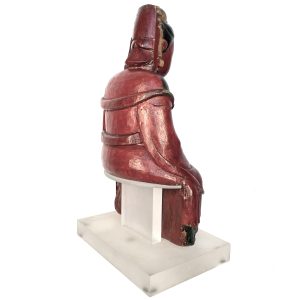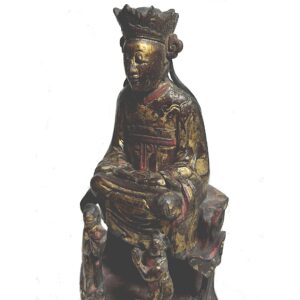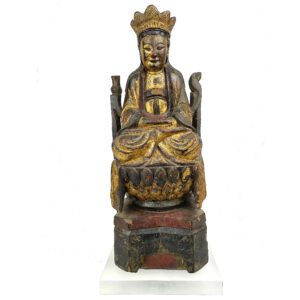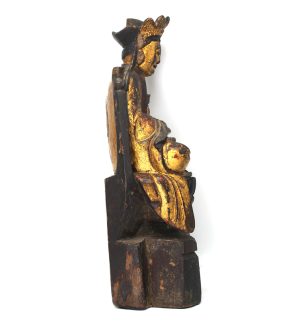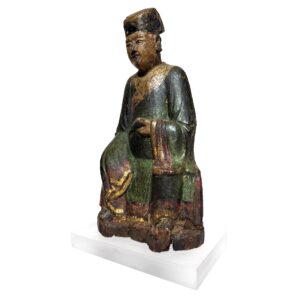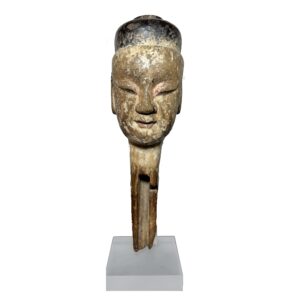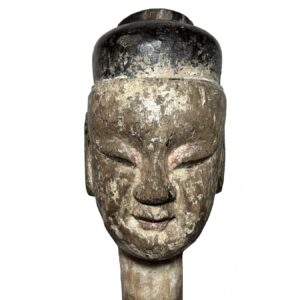Showing 1–12 of 24 results
-
Sale!


$595.00 Original price was: $595.00.$450.00Current price is: $450.00.
H: 15.5″ W: 7″ D: 4.5″ | FREE SHIPPING WITHIN CONTINENTAL U.S.
Reverent female Taoist attendant holding offering plate of 3 dumplings or fruits symbolizing 3 ancient gold or silver coins as a symbol of wealth and a wish for passing 3 imperial examination levels to assure the family’s status and financial stability.
-
Sale!


$295.00 Original price was: $295.00.$195.00Current price is: $195.00.
H: 8.5″ W: 4″ D: 2.75″ | FREE SHIPPING WITHIN CONTINENTAL U.S.!
Antique Chinese puppets were often made in several parts with removable heads. This antique carved head of a beauty has delicately painted features and an animal hair braided down the back. Since there is an area without hair towards the back, she likely originally wore a hat or headdress. A hole on top probably accommodated strings.
-
Sale!


$745.00 Original price was: $745.00.$425.00Current price is: $425.00.
H: 10.25” W: 4.75” D: 3.625” | FREE SHIPPING WITHin Continental U.S.
Taoist God of Wealth (Caishen) portrayed as benevolent authoritative figure associated with wealth: holds tael, robe with coin decorations, painted with red and gold.
-
Sale!


$345.00 Original price was: $345.00.$275.00Current price is: $275.00.
H: 6″ W: 2.5″ D: 4″ | FREE SHIPPING WITHIN CONTINENTAL U.S.
Guan Ti, Chinese God of War and Justice dressed in military armor, officials cap with feathered wings and celestial scarf. Seated on mythical Hǒu . Along with Antique Thunder God Leigong on a Hou 16327. was part of bed carving to protect occupants.
-
Sale!


$695.00 Original price was: $695.00.$525.00Current price is: $525.00.
H: 14.5” W: 5.5” D: 4.25” | FREE SHIPPING within continental u.s.
Guanyin’s elegance, compassion and serenity are emphasized in this provincial carving on 3 tiered high lotus throne on a hexagonal base with carved patterns. Portrayed in meditation with flowing robes this consecrated image was designed for personal veneration in a home setting.
-
Sale!


$1,300.00 Original price was: $1,300.00.$975.00Current price is: $975.00.
H: 13.75” W: 7” D: 4.5” | CALL 213-568-3030 or email [email protected] for shipping
Delicately detailed and consecrated Guanyin in meditation on a backless throne, flowing braids, simple necklace, 3-part crown centered with Amitabha Buddha on lotus throne surrounded by a radiating aureole. Compassionate downcast eyes, serene contemplative expression, calm smile to enhance any surrounding.
-
Sale!


$535.00 Original price was: $535.00.$450.00Current price is: $450.00.
Ht: 10.5” W: 5.5” D: 4” | FREE SHIPPING in continental u.s.
Guanyin in lacquer and gilt sits on a lotus throne in meditation atop a decorative footed stand, regally depicted with elegantly draped robes and a 5-lobe crown with a cross hatch design. Consecrated for home altar use.
-
Sale!


$1,750.00 Original price was: $1,750.00.$1,150.00Current price is: $1,150.00.
H: 21” W: 11.5” D: 8” | FOR SHIPPING call 213-568-3030 or email [email protected]
Temples for “Heavenly Empress” Mazu in southern China coastal regions protect sea faring peoples. This motherly home altar statue reflects that although childless, she protects her children – her devotees – as a mother. Seated on lucite base.
-
Sale!


$1,350.00 Original price was: $1,350.00.$1,200.00Current price is: $1,200.00.
H: 11.5″ W: 6″ D: 4.5″ | FREE SHIPPING IN CONTINENTAL U.S.
Nanhai Guanyin on Mount Putuo sits as a triad with acolytes Shan Tsai hands in prayer and the Dragon Princess offering the “illuminating pearl.” Very rare Ming sculpture on an Acrylic base is one of our favorites VA collection carvings.
-
Sale!


$1,450.00 Original price was: $1,450.00.$1,150.00Current price is: $1,150.00.
H: 15.5″ W: 6″ D: 5.25″ | CALL 213-568-3030 OR EMAIL VANISHINGARTS213@GMAIL/COM for shipping information
Elegant Guanyin in meditation, gilt covered with five-lobed crown. Sacred vial on her right and parrot on left. Guanyins statues with symbols in this condition are rare and impart a feeling of serenity to the environment around them.
-
Sale!


$535.00 Original price was: $535.00.$395.00Current price is: $395.00.
H: 10.3″ W: 6″ D: 3.5″ | FREE SHIPPING IN CONTINENTAL US
Ancestor statue emphasizing his status as an official holding up his belt of office with official’s hat and boots, worn only by those who could afford them. Faded inscriptions on the back of the chair. Mounted on Lucite stand.
-
Sale!


$495.00 Original price was: $495.00.$395.00Current price is: $395.00.
Ht: 22.25” W: 7.25” D: 5” | FREE SHIPPING WITHIN CONTINENTAL U.S.
This detailed male puppet head with a calm expression, round bun and half-smile was very versatile, used in religious or secular performances. Changing costumes and headgear, it could have been a Buddhist, Taoist or Popular Religion figure or deity or non religious character.
End of content
End of content

